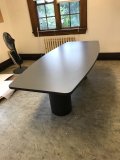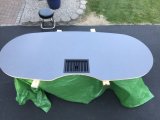Wouldn't take much effort to build a simple 48" long jig with holes drilled 1" apart (that could each hold the second 'nail', aka dowel/pin). One end is nailed to the centerpoint of the table, and then it's just a matter of placing the pin at the right hole location to maximize length, and then setting the string length so that the pencil doesn't leave the 48"x96" dimensions of the table.Some math wizard might know how to rig up a combination of strings and nails to plot a super-ellipse with a pencil… Which could then be turned into a jig.
A basic ellipse is drawn with just two points and a string, with the dimensions determined by how far apart the nails are and how much play is on the string:
Could even scale it down to a 4" x 8" piece for a test run.
Last edited:



